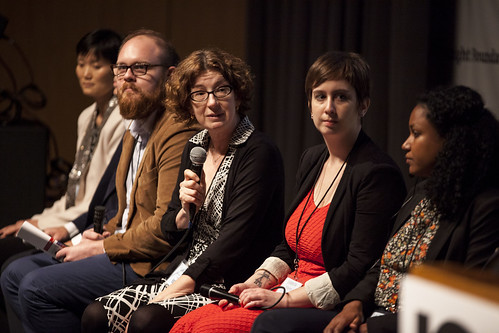April 5, 2014 | Research
First research session at ISOJ 2014 highlights contemporary challenges, opportunities for digital journalism

The first official day of activities at the 15th International Symposium on Online Journalism (ISOJ) came to a close with the presentation of six research projects that addressed current opportunities and challenges for digital journalism. The panel, which addressed topics ranging from the impact of native advertising to the archiving of digital news, was moderated by ISOJ research chair Amy Schmitz Weiss, and featured research undertaken by media scholars from universities in Switzerland, Portugal, Canada and the United States.
The presentations opened with a study of the hyperlink, one of the “old-school” components of online journalism that nowadays is often absent in digital news sites. In a two-year investigation of linking practices in two Belgian outlets, Juliette de Maeyer, with the Université de Montréal, found that the reason for the relative dearth of links in digital news lies beyond the digital newsrooms’ technical capabilities.
Advertising on news sites has become increasingly inconspicuous, with sponsored content often embedded among news contents with few clues to its commercial intent. Patrick Howe and Brady Teufel, with California Polytechnic State University, set out to uncover to what extent this “native advertising” is recognized as such by readers, and what impact it can have on their perception of credibility.
Economic, legal and technological concerns have been major stumbling blocks for the archiving of digital news contents in Canada. The 2014 recipients of ISOJ’s Top Rated Research Paper award, scholars Lisa Lynch with Concordia University in Canada and Paul Fontaine from McGill University provided an in-depth account of the current hurdles for the widespread archival of news—from a lack of direct involvement from Canada’s national library authority to the economic hardships faced by the media industry.

Since before the advent of modern journalism, curiosity has pushed people to seek knowledge about their environs through maps and other sources of historical and geographical information. The advent of geolocation technologies provides a new opportunity for media—specifically the news—to engage readers, according to the research of Claudia Da Silva, with the Universidade Nova de Lisboa and University of Texas at Austin). Exploiting the readers’ curiosity about places can be a powerful strategy, the scholar said, to boost the habit of news reading among younger generations.
Non-traditional formats for the presentation of news contents—as for example, through social media curating platforms—can affect readers’ perceptions of news objectivity, according to the findings presented by Vittoria Sacco of the Université de Neuchâtel and Yanjun Zhao with Cameron University. The authors’ study compared readers’ assessment of news contents in traditional formats versus digital curating platforms; among the experiments’ results, it was shown that the subjects of this study rated traditional formats as more objective.
Newspaper coverage of issues during an election cycle can provide insights about local views on topics such as immigration. In a study of how Florida newspapers framed this issue during the 2012 Republican primary, Alex Ávila, with the University of Texas at Austin, found that the Miami Herald and Orlando Sentinel—as well as their Spanish-language counterparts El Nuevo Herald and El Sentinel—highlighted different aspects of immigration. However, no significant differences were found when comparing the coverage across languages.
ISOJ 2014: Research Pathways Q&A, from Knight Center on Vimeo.

